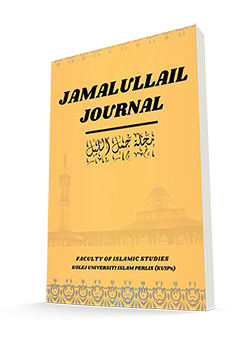Transformatif Pelajar B40 Mendepani Norma Digital: Wakaf Pendidikan Digital Alternatif Terbaik
Transformative B40 Students Facing Digital Norms: Best Alternative Digital Education Waqf
Keywords:
Digital education, B40 students, Education waqf, PerlisAbstract
The national education system will face the fourth phase of the system by 2025, which is the digitalization of Education. Digital education remains relevant and continuous even though the pandemic has ended to support Malaysia's digital education policy implemented by the Ministry of Education Malaysia. The National Digital Education Policy has received the approval of the Cabinet to be implemented immediately to ensure digital fluency among teachers, students, and school leaders. This study aims to measure the transformative level of B40 students undergoing fully digital education at home when the country is hit by the covid 19 pandemic. The involvement in learning of B40 secondary school students in the state of Perlis was measured descriptively through three segments, namely the acceptance of digital learning at home, mastery of technology skills and the excellence of B40 secondary school students in the state of Perlis. This measurement was taken from the perspective of teachers who have experience teaching during Home Teaching and Learning (PdPr) and have B40 students in their classes to be respondents in this study. The results of the study show the transformative level of students in terms of acceptance, mastery of technology and excellence of B40 students during the implementation of PdPr. Therefore, this study proposes a future study on digital education endowments to be implemented as an alternative to help increase the acceptance and excellence of B40 students in digital learning. The results of this study will have an impact on various parties such as the Ministry of Education Malaysia, teachers, parents, and other stakeholders to be more sensitive and concerned about B40 students so that they are not left behind and drop out in digital learning.
Downloads
References
Afriyanti, I., Wardono, W., & Kartono, K. (2018). Pengembangan Literasi Matematika Mengacu PISA Melalui Pembelajaran Abad Ke-21 Berbasis Teknologi. In PRISMA, Prosiding Seminar Nasional Matematika (Vol. 1, pp. 608-617).
Ajmal, M., & Ahmad, S. (2019). Exploration of Anxiety Factors among Students of Distance Learning: A Case Study of Allama Iqbal Open University. Bulletin of Education and
Research, 41(2), 67-78.
Baker, C. (2017). Quantitative research designs: Experimental, quasi-experimental, and descriptive. Evidence-based practice: An integrative approach to research, administration, and practice, 155-183.
Chear, S. L. S., & Yunus, M. M. (2019). Strategi penerapan kemahiran abad ke-21 dalam latihan guru prasekolah. Southeast Asia Early Childhood Journal, 8(1), 1-10.
Cheung, W. S., & Hew, K. F. (2004). Evaluating the extent of ill-structured problem solving process among pre-service teachers in an asynchronous online discussion and reflection log learning environment. Journal of Educational Computing Research, 30(3), 197-227.
Chukwuemeka, E. J. Dominic, S., & Kareem, M. A. (2020). Redesigning Educational Delivery Systems : The Needs and Options for Continuous Learning during the Coronavirus (COVID-19) Pandemic in Nigeria Redesigning Educational Delivery Systems : The Needs and Options for Continuous Learning during the Coronavirus. December. https://doi.org/https://doi.org/10.30935/cedtech/XXXX
Creswell, J. W. (2005). Educational research: Planning, conducting, and evaluating quantitative and qualitative research (2nd ed.). Pearson Education.
De Giusti, A. (2020). Policy Brief: Education during COVID-19 and beyond. Revista Iberoamericana de Tecnología En Educación y Educación En Tecnología, 26, e12. https://doi.org/10.24215/18509959.26.e12
Dong, C., Cao, S., & Li, H. (2020). Young Children’s Online Learning During COVID-19
Pandemic: Chinese Parents’ Beliefs and Attitudes. Children and Youth Services
Review, 118, 105440.
Free Malaysia Today (September 21-2021). 51% murid sekolah rasa tertekan dengan PdPR, kata KPM. FMT Reporters. https://www.freemalaysiatoday.com/category/bahasa/tempatan/2021/09/21/51-murid-sekolah-rasa-tertekan-dengan-pdpr-kata-kpm/.
Hodges, C. B., Moore, S., Lockee, B. B., Trust, T., & Bond, M. A. (2020). The difference between emergency remote teaching and online learning.
Hung, M. L., Chou, C., Chen, C. H., & Own, Z. Y. (2010). Learner Readiness For Online
Learning: Scale Development And Student Perceptions. Computers & Education, 55(3), 1080-1090.
Jabatan Perangkaan Malaysia. (2022, February). Statistik Subnasional Negeri Perlis. In Jabatan Perangkaan Malaysia (ISBN 978-967-2000-88-4). https://www.dosm.gov.my
Joshi, A., Vinay, M., & Bhaskar, P. (2021). Impact of Coronavirus Pandemic on the Indian Education sector: Perspectives of Teachers on Online Teaching and Assessments. Interactive Technology and Smart Education, 18 (2), 205–226. https://doi.org/10.1108/ITSE-06-2020-0087
Kaur, S. (2017). Review article sample size determination (for descriptive studies). International Journal of Current Research, 9(3), 48365–48367. https://www.journalcra.com/article/sample-size-determination-descriptive-studies
Machin, D., Campbell, M. J., Tan, S. B., & Tan, S. H. (2018, August 20). Sample Sizes for Clinical, Laboratory and Epidemiology Studies (4th ed.). Wiley-Blackwell.
Mamat, S. (2020). Aplikasi Google Meet Dalam Program 3c Bagi Meningkatkan Motivasi
Pelajar Tingkatan 5. Proceedings of International Conference on Global Education VIII, hlm. 140-150.
S Mertler, C. A. (2014). Action Research: Improving Schools and Empowering Educators (4th ed.). SAGE Publications, Inc.
Mohd Amin, N. A., & Mohamad Nasri, N. (2021). Kajian Tinjauan Persepsi Murid Sekolah Menengah Terhadap Pembelajaran Dalam Talian Semasa Pandemik Covid-19. Jurnal Dunia Pendidikan, 3(2), 344–361. http://myjms.mohe.gov.my/index.php/jdpd
Sah Alam, S. N., Hassan, M.S., Sultan Mohideen, R., Ramlan, A.F., & Mohd Kamal, R. (2020).
Online Distance Learning Readiness During Covid-19 Outbreak Among
Undergraduate Students. International Journal of Academic Research in Business &
Social Sciences, 10(5): 642-657.
Saleh, M. N. (2019). Berijazah Secara PJJ Di Malaysia Peluang, Cabaran, Ciri dan Gaya
Pembelajaran Pelajar, dan Strategi Kejayaan (Penerbit USM). Penerbit USM.
Sample Size Calculator by Raosoft, Inc. (n.d.). Retrieved October 5, 2022, from http://www.raosoft.com/samplesize.html
Yahaya, M., Hanafiah, R., Zakaria, N. S., Osman, R., & Bahrin, K. A. (2020). Amalan
Pembelajaran Abad Ke-21 (PAK21) Dalam Pengajaran Dan Pemudahcaraan (PdPc)
Guru-Guru Sekolah Rendah. Jurnal IPDA, 26(1), 13-24.
Yusup, H. (2012). Penggunaan e-Pembelajaran dalam Pengajaran dan Pembelajaran yang
Berkesan (Doctoral dissertation, Asia e University).
Zhu, M., Bonk, C. J., & Sari, A. R. (2018). Instructor Experiences Designing MOOCs in Higher
Education: Pedagogical, Resource, and Logistical Considerations and
Challenges. online learning, 22 (4), 203-241.
Downloads
Published
How to Cite
Issue
Section
License
Copyright (c) 2024 Nur Syamilah Md Noor , Nur Syaedah Kamis, Mardziyah Mohd Isa

This work is licensed under a Creative Commons Attribution 4.0 International License.





